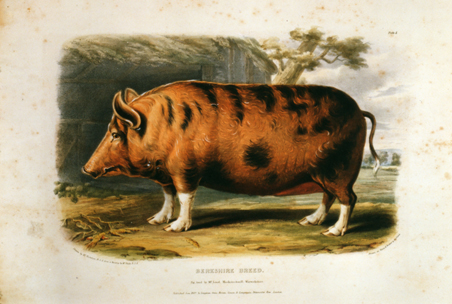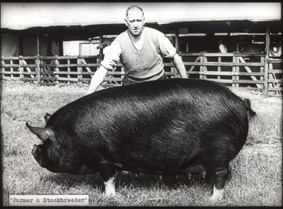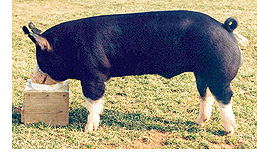SCIENCE and PRACTICE - complementary or conflicting? Combining the science of genetics and the art of animal breeding
- The Advance of Technology; benefits and drawbacks
- A Balanced Approach; reconciling improvement and diversity
- What measures should be used?; breed integrity and genetic diversity
- Current Work; projects in hand - assignment to breed, breeds at risk definitions, cyclic crossing, ram testes
The Advance of Technology
The science of genetics in the second half of the twentieth century was directed to programmes of intensive selection of major production genes to achieve rapid progress in raising the level of performance of farm livestock. The science of genetics replaced the art of animal breeding. The advance of technology, expressed in many forms from computer software to embryo transfer, superseded the eye of the breeder as the basis for the selection of breeding stock.
The advantages are readily apparent. Progress towards the desired target is accelerated, and was seen in dramatic increases in lactation yield of dairy cows or reduced depth of backfat in pigs.
The disadvantages were not realised for some time, but now are being more fully understood. Rapid change should be interpreted as progress only if it proceeds in a positive direction. The loss of functional soundness in high-yielding dairy cows, and the lack of flavour in lean pork, caused many breeders to pause and revise their opinions. Breeds which retained traditional qualities were marginalised in the rush for 'superior' genetics, and diversity of the livestock industry was adversely affected.
A Balanced Approach
The advantages potentially facilitated by advanced technology are not disputed, but its unbridled application can have damaging effects. The domination of the global livestock industry by a few breeds, expanding on a platform of advanced technology, has severely undermined diversity of animal genetic resources (AnGR) by marginalising local breeds with the loss of traits that will be vital in the future of food security. The principles of conservation of genetic diversity should be given greater priority. Genetic conservation requires the reconciliation of genetic improvement and genetic diversity. Additionally, factors such as local adaptation, animal welfare and product quality must be given higher priority.
The theory of science must not ignore the commonsense of practical experience. Pure genetics is mathematical science and its conversion to applied genetics must absorb some of the art of animal breeding. A simple example will provide illustration. Textbooks of genetics (depending on the reference used) tell us that the heritability of prolificacy in sheep varies from 5% to 15%. This may be accurate for ewes that lamb at 150%, but is dangerously misleading for breeds that lamb at 300% where heritability is nearer 30%. Thus the efficient process of creation and development of the British Milksheep (Alderbred), with an ALS of 3.07, was built on a blend of the science of genetics and an inherent understanding of sheep. It would have followed a much more difficult and ineffective path if it had adhered to accepted wisdom and applied only current genetic theory.
What measures should be used?
Breeding programmes for major production traits have been rehearsed in many publications, and do not require repetition here. They are measured easily in controlled environment and changed rapidly by high selection intensity.
We are more concerned to encourage the inclusion of other qualities which are less easily measured, but which are very relevant to efficient and sustainable production. The values of local adaptation, longevity, thriftiness and grazing behaviour now are recognised, but they had been ignored until recently because they did not lend themselves to simple evaluation. They are measured most effectively in extensive systems of production favoured by native breeds such as the White Park.
Measures of within-breed diversity can be measured with relative ease, and the maintenance of diversity should be an integral part of breeding programmes. The low within-breed diversity of local pig breeds in Europe (as well as their major contribution to genetic diversity in the wider population) was reported by PigBioDiv1 (see paper on 'Diversity in European Pigs' on 'Papers and Articles' page). Similarly, Blott demonstrated a significant loss of diversity in the small population of pure Hereford cattle in the UK between the 1960s and 1990s.
Animal breeding programmes in the future should combine selection for preferred traits with the maintenance of within-breed diversity.
New aids to genetic improvement are offered continually, and should not be ignored. They can provide information on a range of traits (e.g. lean meat, marbling, tenderness, disease resistance, etc). They can assist breeders to make accurate and early selection of breeding stock, but the dangers must not be ignored. Pursuit of such policies without regard for the genetic integrity of a breed, and without monitoring the effect on within-breed diversity of the purebred population, is a dangerous short-term expedient. Recent decades have seen the Dairy Shorthorn transformed from a traditional dual-purpose breed into an extreme dairy type by 'official' introgression of exotic breeds such as the Holstein. The pure Dairy Shorthorn now is an endangered breed (recognised by Rare Breeds International as a 'breed at risk') yet at the same time its original character and qualities are becoming increasingly valued as we move away from cattle that require high-energy inputs. The work of a small group of breeders is directed to saving the pure breed as the Native Milking Shorthorn in USA and Original Dairy Shorthorn in UK. A small population exists in Australia and there may be one or two pure animals in South Africa and Canada.
Some breeds are critically endangered. In the UK both Vaynol cattle and Northern Dairy Shorthorn cattle have less than 100 breeding females; the former are especially at risk (see 'Papers & Articles' page). In other cases extinct breeds have been revived in name without acknowledging they are extinct. They include UK breeds such as Blue Albion cattle and Oxford Sandy & Black pigs. The need for coherent definitions and policy is obvious.
Specific Projects. A wide variety of projects are in progress, but the following give an indication of the range:
DNA profiling: developing DNA breed profiles and analytical systems to enable accurate assignment to breed of individual animals and thus maintain genetic integrity. Sophisticated analyses can detect historical admixture in most breeds, but systems based on allele frequency are the preferred option. I have applied an in-house version of that option for several cattle, sheep, pig and equine breeds. Some breeds have evolved in a relatively uncomplicated manner; others have passed through phases of introgression and change of type. Berkshire pigs in the mid-eighteenth c entu
entu ry we
ry we re brown and black (picture right); following the introduction of Neapolitan blood around 1800, they became black with white points (picture centre, mid-20C); the pigs exported to North America were modified to meet different conformation criteria (picture left; early 21C). These changes can be detected through various DNA tests, and pigs imported to Japan from USA and Australia must undergo these tests.
re brown and black (picture right); following the introduction of Neapolitan blood around 1800, they became black with white points (picture centre, mid-20C); the pigs exported to North America were modified to meet different conformation criteria (picture left; early 21C). These changes can be detected through various DNA tests, and pigs imported to Japan from USA and Australia must undergo these tests.
Cyclic crossing: also known by other names such as rotational mating, it is a technique used to limit the level of inbreeding in a breed without losing the distinctive traits of lines or families within the breed. It is particularly valuable in small populations, and has been used with great success with Caspian horses, Portland sheep, Gloucestershire Old Spots pigs and Shetland cattle.
Breeds at Risk: developing the primary indicators of endangerment (i.e. numerical scarcity, geographical concentration, genetic erosion) which underpin systems for the definition, identification and evaluation of breeds at risk.
Fertility and Fecundity: measurement of testes size in rams and bulls as an indicator of prolificacy and fertility. The heritability of testes diameter is 24% and may be a useful indicator of prolificacy in sheep. This technique was used in the development of BMS. The cattle project uses a measure of scrotal circumference and has been concerned more with comparison between breeds